https://www.moneycontrol.com/news/india/comment-oil-at-250-a-barrel-how-we-could-get-there-and-indias-quandary-2706781.html
US misadventures with Iran could push oil to $250 a barrel, leaving stark choices for India
RN Bhaskar — Jul 13, 2018
With scary forecasts doing the rounds over the price of crude oil, Artem Avinov, leading analyst with TeleTrade, was quick to add that $250 a barrel was a possibility and not a probability.
Earlier this week, most oil market watchers were startled when they came across reports that oil prices could shoot to $250 a barrel (https://www.rt.com/business/432075-iran-strait-hormuz-oil-prices/). This prediction was made by Artem Avinov, leading analyst with TeleTrade, who was quick to add that it was a possibility and not a probability. But there are other scary forecasts doing the rounds.
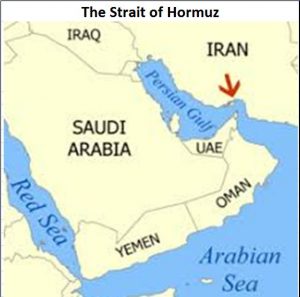 All this stems from the threat issued by Iran’s Revolutionary guards that Iran could block the Strait of Hormuz, a crucial artery for oil and LNG shipments, if Iran’s oil exports were harmed in any way.
All this stems from the threat issued by Iran’s Revolutionary guards that Iran could block the Strait of Hormuz, a crucial artery for oil and LNG shipments, if Iran’s oil exports were harmed in any way.
It must be remembered that almost half the world’s daily supply of crude passes through the Hormuz Strait (see map). Much of the crude from Saudi Arabia, Iran, the United Arab Emirates, Kuwait, and the LNG from Qatar passes through the Strait of Hormuz. Another analyst Vladimir Rojankovski, expert at the International Financial Center in Moscow, told RT, that if exports through the Strait of Hormuz stop, “the law of supply and demand would double oil prices to $160 per barrel.”
Is that possible? Yes. All that Iran has to do is to send in two tankers into the Strait and let them burn. The world’s oil trade will be at risk.
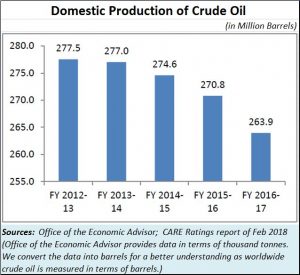 Moreover, Iran has always been one of the top three oil suppliers to India after Saudi Arabia and Iraq). But during the past decade, India’s ability to plan its oil imports sensibly has been jeopardized because of the manner in which the US has played havoc in the Middle East – first with Iraq, then with Iran, then once again with Iraq, followed by Libya and Syria.
Moreover, Iran has always been one of the top three oil suppliers to India after Saudi Arabia and Iraq). But during the past decade, India’s ability to plan its oil imports sensibly has been jeopardized because of the manner in which the US has played havoc in the Middle East – first with Iraq, then with Iran, then once again with Iraq, followed by Libya and Syria.
Reasons
Ostensibly, the present crisis stems from the US deciding unilaterally that it would not honour an agreement reached in 2015 with Iran on the manner in which it should continue with its nuclear plans. President Trump declared that the assurances given by Iran were not worth the paper they were signed on. While the other Security Council members have decided to honour the agreement, the US has decided to reject the agreement, and has unilaterally imposed sanctions against Iran. It has also warned every country of the sanctions being extended to them as well if they had anything to do with Iran.
However, on May 17, the European Commission declared the US sanctions against Iran null and void in Europe. The Commission also instructed the European Investment Bank to facilitate European companies’ investment in Iran. On account of this, the blocking by the US of all banking transactions will not be possible this time. The US had succeeded in doing this last time, when many members of the Security Council members agreed to curb nuclear proliferation by Iran. But these crippling sanctions were eased once an agreement on this issue had been worked out. But that thaw ended when President Trump decided to abrogate the agreement.
What should India do?
The biggest problem for India is that it cannot afford to antagonise the US. At the same time, India is one of the largest importers of oil 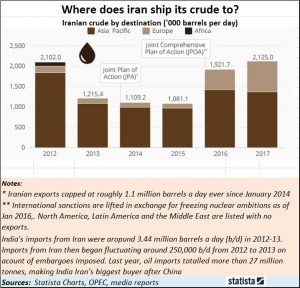 from Iran. Last year alone, the west Asian country supplied India over 27 million tonnes, making us Iran’s biggest buyer after China. That, in turn, makes the US breathe more heavily down the necks of Indian legislators in an attempt to “isolate Iran”.
from Iran. Last year alone, the west Asian country supplied India over 27 million tonnes, making us Iran’s biggest buyer after China. That, in turn, makes the US breathe more heavily down the necks of Indian legislators in an attempt to “isolate Iran”.
India has been told to take oil imports to “zero” by the cut-off date of November 4. If India rejects US pressure, it risks sanctions as well. As things stand, the US has also been pressuring India to reduce arms purchases from Russia, a move that India could find strategically unwise.
If India submits to the US demand, it sours a relationship with an old ally. India has strategic interests in Iran as well. There is the Chabahar port (where it plans to invest $500 million) and the International North South Transport Corridor (INSTC) with an investment outlay of around $2 billion. Moreover, five months ago, in a highly publicized welcome for Iran’s President Hassan Rouhani, India promised to increase its oil imports by 25% this year. It also began negotiating a role for itself in the Farzad-B gas fields.
Significantly, Iran’s other oil importers, China and Turkey, have said they will not accept the US diktat.
So, what should India do? That is difficult to say at the moment. For now India is trying to negotiate a deal with the US. It has also opened channels with China, which could make India China trade as vitally important as the US-Canada trade. It is worth bearing in mind that the most robust cross border trade in the world is between the US and Canada which is estimated at over $2 billion every day.
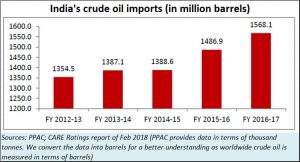 China has already secured its energy interests by building oil and gas pipelines with Russia, Kazakhstan and Myanmar. Russia has a robust trade with Germany which has refused to join the US in its sanctions against either Russia or Iran.
China has already secured its energy interests by building oil and gas pipelines with Russia, Kazakhstan and Myanmar. Russia has a robust trade with Germany which has refused to join the US in its sanctions against either Russia or Iran.
This does make India appear a bit more vulnerable than other players in the region. This is because, despite its domestic production, India needs to import a lot of oil.
What is more worrisome is that should Iran carry out its threat of blocking the Strait of Hormuz, the only big beneficiary will be the US, because it is already on its way to becoming the world’s top oil producer. Moreover, its profits also come from its equity stakes in almost every oil and gas exploration company in West Asia, excepting Iran, That would explain why the US could be a very interested party is keeping the oil markets jittery.
This should also make India more wary of each move that the US makes. After all, it has already re-emerged as the biggest warmonger in the world. Of course, this has to be balanced with the imperative of keeping Trump, who appears reasonably favourably disposed to the country, onside. A newspaper report even suggests that India wants him to be chief guest at next year’s Republic Day festivities.
Moreover, India’s policymakers should learn from these developments and wean the country away from oil and gas. It can only do this if it focuses more urgently on (rooftop) solar power. (http://www.moneycontrol.com/news/business/dear-pm-modi-heres-how-bureaucrats-are-planning-to-scuttle-your-rooftop-solar-employment-plans-2468501.html). It also needs to introduce policies to accelerate plans for methane generation (https://www.moneycontrol.com/news/business/economy/comment-the-spinoff-from-swachh-bharat-wealth-from-waste-could-be-big-sht-2556797.html).
Most of all, it could be time that the EU, China, Russia and India – which together represent over 60% of the world’s purchasing power – start thinking in terms of promoting a new global currency. The pressures that the US can unleash because of its stranglehold over banking are far too risky for the entire world.
But why does the US dislike Iran?
Both the UK and the US dislike Iran. The tensions go back to the 1950s when the UK refused to pay to Iran the royalties that the country wanted for the oil extracted there. In 1951, Mohammad Mosaddegh – a popular, democratically elected head of government — nationalised Iran’s petroleum industry because of this reason.
In retaliation, the UK did precisely it did to China during the Opium war. It introduced a sea blockade – this time it was to block the flow of oil from Iran to the world. Without oil revenues, Iran could not feed its hungry millions. There were riots, which are believed to have been engineered by both the CIA and the UK’s Secret Intelligence Service. Mossadegh was removed from power, and the US and the UK installed the west-leaning Shah Reza Pahlavi.
But the tipping point against the fawning Shah occurred in 1979 when he agreed to the US demand that no US citizen could be tried by an Iranian court, even for crimes committed inside Iran. Popularly referred to as the capitulation clause, it wounded national pride, and caused an uproar of protest. The Shah was overthrown and Ruhollah Khomeini became the Supreme Leader.
The US embassy was encircled and its staff members were taken prisoner. Attempts by Ronald Reagan to free them by sending in helicopters also failed, and the occupants of the two helicopters were captured and added to the list of prisoners. After 400 days of captivity, the prisoners were released unharmed. Details of the negotiations between the US and Iran have not been made public. The US has not forgotten this humiliation.
That could possibly explain why the US decided to arm Saddam Hussain and with a wink and nod allowed him to attack Iran. Unfortunately, Saddam decided to annex Kuwait which lay in the path to Iran. That was something the US did not want as it had promised Kuwait protection. George Bush Sr, who was president at that time, told Saddam to liberate Kuwait. Saddam refused. The US asked the other Security Council members to get the UN to pass a resolution demanding that Saddam withdraw. The others refused, stating that they were not consulted when Saddam was armed for the Iraq-Iran conflict.
This something amazing happened. In order to change public sentiment, the US is believed to have hired public relations agency H&K to fabricate a story – a story that was even taken up by the US Senate. The story was that of a 14 year old Kuwaiti princess, Nayirah, who just about managed to escape being raped by Iraqi soldiers. In order to escape them, she ran into a building which turned out to be a hospital. She landed up in the ward for premature babies – each in its oxygen incubation tent.

Sobbing, she narrated to a television camera how she had concealed herself inside a cupboard. She described how the soldiers came into the incubation chamber, and because the oxygen tents blocked their view, how they tore apart the tents. In a choked voice she explained how she heard the babies gasp and die, but dared not cry out herself, for fear of being raped. A grave digger then gave his testimony about how he had “personally” buried several prematurely born babies.
The TV show became viral, and spread all over the continent. Enraged, the Europeans joined hands with the US and got the UN to issue an order asking Saddam to withdraw. However, when the second Iraq war began – under the Junior Bush’s presidency, a Canadian investigative journalist discovered that there was no Kuwaiti princess at all (see just four minutes of the video at https://www.youtube.com/watch?v=BgbhALwH9DY from timeline 20:20) . The girl who had told her story, and then repeated it before the US Senate, was the daughter of the Kuwaiti Ambassador to the US. She had been trained to tell this story convincingly. Amnesty International then issued a public apology, because it too had been misled.
This was the second time that the US failed to beat Iran into submission.
The age of state terrorism
However, when Saddam got a bit more belligerent and did not toe the US line any further, he too became a threat. He was accused of harbouring weapons of mass destruction (WMD) and the US declared war against him. Once again, some European countries – especially France – did not join the US war-cry against Iraq, prompting anger in America and the rechristening of French fries as Freedom Fries. The countries which agreed to join the US against Iran were called the Coalition of the Willing. And Bush Junior made his infamous declaration that “If you are not with us, you are against us”.
Eventually, it was confirmed that there were no WMDs.
As Nobel Award winner (2005) Harold Pinter stated in his Nobel award address, “The invasion of Iraq was a bandit act, an act of blatant state terrorism, demonstrating absolute contempt for the concept of international law. The invasion was an arbitrary military action inspired by a series of lies upon lies and gross manipulation of the media and therefore of the public; an act intended to consolidate American military and economic control of the Middle East masquerading – as a last resort – all other justifications having failed to justify themselves – as liberation. A formidable assertion of military force responsible for the death and mutilation of thousands and thousands of innocent people. the attack on Iraq was a bandit act.” (https://www.nobelprize.org/nobel_prizes/literature/laureates/2005/pinter-lecture-e.html)
Subsequently, the US helped obliterate Libya as we knew it and almost destroyed Syria.
Unilaterism prevails
Today, sadly, the US is trying to play the same game of unilateralism. What is worse, many see the US waging war against two of the most ancient civilisations in the world, Iran and Iraq.
And Iran, like North Korea, knows that if Saddam really had had nuclear arms, it would probably not have been invaded and destroyed.
In fact, during the past 75 years, the US is the only country that has used weapons of mass destruction, with impunity. It has used them to test new nuclear weapons as the amazing documentary by award winning John Pilger shows (The coming war on China).
The US even refuses to be a state party to the Rome Statute of the International Criminal Court — to ensure that no American ever stands trial before an international court.
Obviously, these are difficult times — through which people, countries and trade must navigate. The current moves against Iran have the potential of disrupting much of what the world has built over the past century. Hopefully, these winds will pass. But then they might even intensify and become a tornado. If oil does indeed hit $250, or, more likely, $160, Armageddon could be around the corner.




























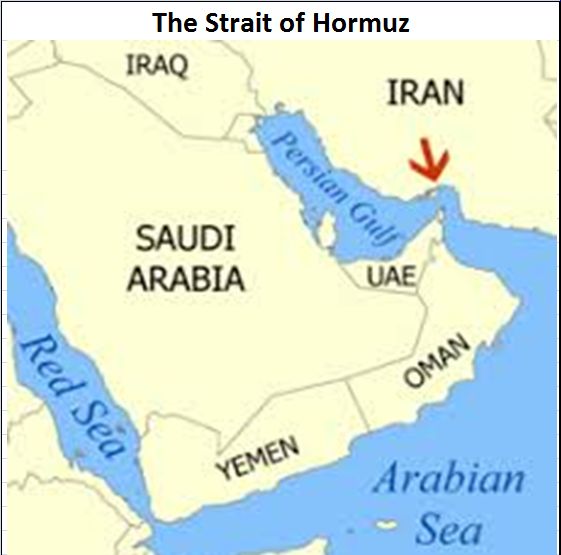










COMMENTS